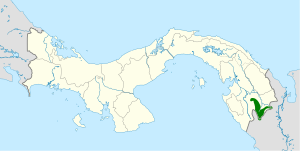Choco tinamou facts for kids
Quick facts for kids Choco tinamou |
|
|---|---|
| Conservation status | |
| Scientific classification | |
| Genus: |
Crypturellus
|
| Species: |
kerriae
|
 |
|
| Synonyms | |
|
Crypturus kerriae |
|
The Choco tinamou (Crypturellus kerriae) is a special bird found in the forests of Colombia and Panama. It lives in both lowland and mountain forests in warm, wet areas. This bird is a type of tinamou, which are birds that look a bit like chickens but are related to bigger birds like ostriches.
Contents
What the Choco Tinamou Looks Like
The Choco tinamou is a small bird, about 25 to 26.5 centimeters (10 to 10.5 inches) long. It has dark brown feathers on its back and a blackish head. Its throat is whitish, and its legs are bright red! The sides of its neck are a slate-grey color. Female Choco tinamous are a bit darker than males. They also have more patterns on their wings and chest.
Choco Tinamou Behavior and Diet
The Choco tinamou has a soft, sad-sounding whistle with three notes. It's a quiet bird. Like other tinamous, it mostly eats fruit that has fallen to the ground or grows on low bushes. They also snack on small insects, flower buds, soft leaves, seeds, and roots.
Raising Young Tinamous
The male Choco tinamou is in charge of raising the young. He incubates the eggs, which can come from up to four different females. After the eggs hatch, he takes care of the chicks until they are ready to live on their own. This usually takes about two to three weeks. Their nest is built on the ground, often hidden in thick bushes or between large tree roots.
Understanding Choco Tinamou Taxonomy
The Choco tinamou is a single species, meaning there are no different types of Choco tinamous. All tinamous belong to the bird family called Tinamidae. These birds are also part of a larger group called ratites. Other ratites include ostriches, emus, and rheas.
Can Tinamous Fly?
Unlike most other ratites, tinamous can fly! However, they are not very strong fliers. Scientists believe that all ratites came from ancient birds that could fly. Tinamous are the closest living relatives to these very old flying birds.
Meaning of the Name Crypturellus
The scientific name for the Choco tinamou is Crypturellus kerriae. The word Crypturellus comes from three old words:
- kruptos (Greek) means covered or hidden
- oura (Greek) means tail
- ellus (Latin) means small
So, Crypturellus means "small hidden tail." This name fits because tinamous have very short tails that are often hidden by their feathers.
Where the Choco Tinamou Lives
This bird is found in specific parts of northwestern Chocó Department in Colombia. It also lives in the southern Darién Department in Panama.
Choco Tinamou Habitat
The Choco tinamou lives in tropical and subtropical moist evergreen forests. These are forests that stay green all year round. They can be found in lowlands and in mountains up to about 1,500 meters (4,900 feet) high. It seems they prefer to live in the higher parts of these forests.
Threats to the Choco Tinamou
The Choco tinamou is currently facing many dangers. Its forest home is being destroyed by people building roads and new towns. Trees are also cut down for wood, and mining activities harm the land.
Habitat Loss and Human Activity
A new road and bridge have made it easier for people to reach areas near the Ensenada de Utría National Park. This means more people are settling there, which threatens the tinamou's home. In the Atrato valley in Colombia, many forests are being turned into farms and banana plantations. This is a big problem for the birds living there. People also hunt the Choco tinamou in areas where humans live.
Future Dangers
There are also plans for big transportation projects, like a highway through Darién and canals for rivers. These projects are currently on hold. However, if they are completed, they could cause serious harm to the Choco tinamou's habitat. The biggest threats are hunting and these large construction plans.
Protecting the Choco Tinamou
The Choco tinamou is protected in some special places. These include Darién National Park in Panama and Ensenada de Utría National Park in Colombia. Another park, Los Katíos National Park in Colombia, has suitable habitat, but the bird hasn't been officially seen there yet.
Why It's Vulnerable
Scientists have suggested studying the bird's habitats and how it lives to better understand its situation. The Choco tinamou is considered a Vulnerable species. This means it is known from only a few places, and its habitat is slowly disappearing. Its total range is about 6,200 square kilometers (2,400 square miles). In 2000, it was estimated that there were fewer than 10,000 adult birds left.
See also
 In Spanish: Inambú chocó para niños
In Spanish: Inambú chocó para niños


